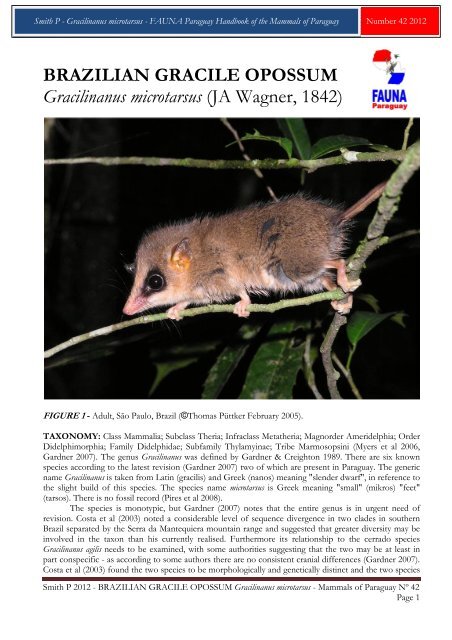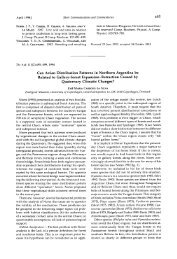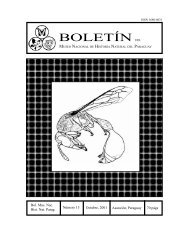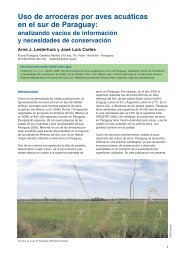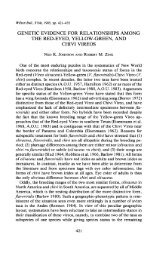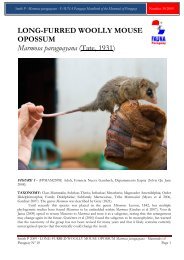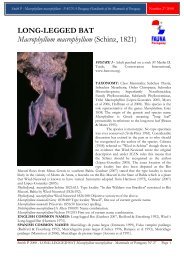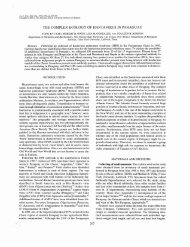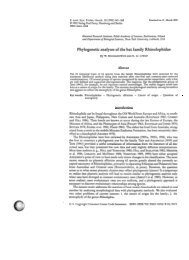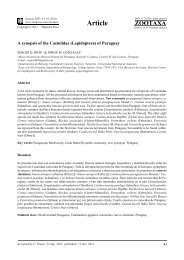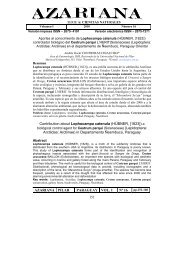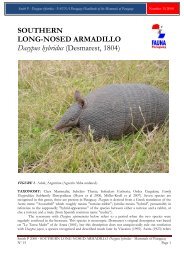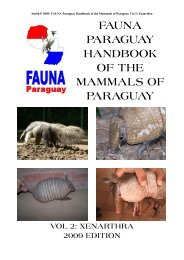Smith P 2012 - FAUNA Paraguay
Smith P 2012 - FAUNA Paraguay
Smith P 2012 - FAUNA Paraguay
Create successful ePaper yourself
Turn your PDF publications into a flip-book with our unique Google optimized e-Paper software.
<strong>Smith</strong> P - Gracilinanus microtarsus - <strong>FAUNA</strong> <strong>Paraguay</strong> Handbook of the Mammals of <strong>Paraguay</strong> Number 42 <strong>2012</strong><br />
BRAZILIAN GRACILE OPOSSUM<br />
Gracilinanus microtarsus (JA Wagner, 1842)<br />
FIGURE 1 - Adult, São Paulo, Brazil (©Thomas Püttker February 2005).<br />
TAXONOMY: Class Mammalia; Subclass Theria; Infraclass Metatheria; Magnorder Ameridelphia; Order<br />
Didelphimorphia; Family Didelphidae; Subfamily Thylamyinae; Tribe Marmosopsini (Myers et al 2006,<br />
Gardner 2007). The genus Gracilinanus was defined by Gardner & Creighton 1989. There are six known<br />
species according to the latest revision (Gardner 2007) two of which are present in <strong>Paraguay</strong>. The generic<br />
name Gracilinanus is taken from Latin (gracilis) and Greek (nanos) meaning "slender dwarf", in reference to<br />
the slight build of this species. The species name microtarsus is Greek meaning "small" (mikros) "feet"<br />
(tarsos). There is no fossil record (Pires et al 2008).<br />
The species is monotypic, but Gardner (2007) notes that the entire genus is in urgent need of<br />
revision. Costa et al (2003) noted a considerable level of sequence divergence in two clades in southern<br />
Brazil separated by the Serra da Mantequiera mountain range and suggested that greater diversity may be<br />
involved in the taxon than his currently realised. Furthermore its relationship to the cerrado species<br />
Gracilinanus agilis needs to be examined, with some authorities suggesting that the two may be at least in<br />
part conspecific - as according to some authors there are no consistent cranial differences (Gardner 2007).<br />
Costa et al (2003) found the two species to be morphologically and genetically distinct and the two species<br />
<strong>Smith</strong> P <strong>2012</strong> - BRAZILIAN GRACILE OPOSSUM Gracilinanus microtarsus - Mammals of <strong>Paraguay</strong> Nº 42<br />
Page 1
<strong>Smith</strong> P - Gracilinanus microtarsus - <strong>FAUNA</strong> <strong>Paraguay</strong> Handbook of the Mammals of <strong>Paraguay</strong> Number 42 <strong>2012</strong><br />
have been found in sympatry in at least one locality in Minas Gerais, Brazil (Geise & Astúa 2009) where<br />
the authors found that they could be distinguished on external characters alone.<br />
Patton & Costa (2003) commented that the species presence at Lagoa Santa, Minas Gerais, the<br />
type locality for G.agilis, raises the possibility that the type specimen of that species may in fact prove to be<br />
what is currently known as G.microtarsus. In this case the next available name for G.agilis would be G.beatrix<br />
(O.Thomas 1910).<br />
The description of the cryptic and hitherto unnoticed genus Cryptonanus by Voss, Lunde & Jansa<br />
(2005) confused the situation yet further. This species is sympatric with Cryptonanus guahybae (Tate 1931) in<br />
the extreme south of its Brazilian range (Sta Catarina) and also overlaps with Cryptonanus chacoensis (Tate<br />
1931) in the western part of its range (<strong>Paraguay</strong>, southwestern Brazil and Misiones, Argentina). To what<br />
extent these species have been confused in the literature is unclear but every effort has been made to<br />
quote references that refer unequivocally this species. Synonyms adapted from Gardner (2007):<br />
Didelphys microtarsus JA Wagner 1842:359. Type locality "Ypanema", São Paulo, Brazil.<br />
Grymaeomys microtarsus Winge 1893:24. Name combination.<br />
Marmosa microtarsus O.Thomas 1900:546: Name combination.<br />
Marmosa microtarsus microtarsus Tate 1933: 190. Name combination.<br />
Marmosa herhardti A.Mirando.Ribeiro 1936:382. Type locality "Humboldt", Santa Catarina Brazil.<br />
Marmosa [(Thylamys)] microtarsus Cabrera 1958:31. Name combination.<br />
[Thylamys] microtarsus Reig, Kirsch & Marshall 1987:7. Name combination.<br />
Gracilinanus microtarsus Gardner & Creighton 1989:6. First use of current name.<br />
ENGLISH COMMON NAMES: Brazilian Gracile Opossum (Gardner 2007), Brazilian Gracile Mouse<br />
Opossum (Wilson & Cole 2000, Cannevaro & Vaccaro 2007).<br />
SPANISH COMMON NAMES: Marmosa de pies chicos (Massoia et al 2000), Marmosa grácil brasileña<br />
(Emmons 1999), Marmosa pie chico (Chebez1996), Comadrejita misionera (Massoia et al 2000),<br />
Comadrejita de pies chicos (Cannevaro & Vaccaro 2007), Comadrejita pies chicos (Chebez 2009).<br />
GUARANÍ COMMON NAMES: Anguyá-guaikí (Cannevaro & Vaccaro 2007).<br />
DESCRIPTION: A small, slender mouse opossum with fairly long, lax, rough pelage and long overhairs<br />
when compared directly to other members of the genus. Dorsal pelage reddish-brown to chestnut-brown.<br />
Individual dorsal hairs with a tricolour pattern, the base being dark brown or gray, tips orange to buffy,<br />
and extreme tips dark brown or blackish. The orange-buffy portion of the hairs is longer than in G.agilis.<br />
When viewed dorsally the head is abruptly paler than the colouration of the body, resulting in a sharp<br />
contrast. Eye rings black, large and broad, frequently (though not always) extending from the nose to the<br />
ear. Ventral pelage buffy-white, with a dark greyish base to the hairs except for the chin, which has selfbased<br />
pelage. Glandular areas may show more intense pigmentation. Males possess a gular gland. Ears<br />
moderately large and rounded, pale brownish in colour. Vibrissae well-developed and fairly long. Feet pale<br />
pinkish. Claws on the manus do not extend beyond the digital pads. Palmar and plantar surfaces have<br />
tubercles separated by at least a double row of granules sparsely distributed on central plantar surfaces, and<br />
fused into transverse bars on the proximal ventral surface of the digits. Tail unicoloured fuscous, lightly bicoloured<br />
(darker above and paler below) and 1.3-1.5x head and body length. Tail is prehensile and lacks<br />
hair on the ventral surface at the tip. Caudal scales are rounded to square, arranged in annular series and<br />
each bears three spiny, almost invisible hairs. Females lack a pouch. Mammae are hidden when the female<br />
is not lactating, and arrangement is bilateral with one or rarely a few occurring in the medial abdomen.<br />
Pectoral mammae 2-0-2 =4 and abdominal-inguinal mammae 5-1-5 = 11, total 7-1-7 = 15. Unused nipples<br />
may atrophy however. (Tate 1933, Pires 2008).<br />
SKELETAL CHARACTERISTICS: Skull short and broad with pointed muzzle. Nasals narrow,<br />
moderately expanded basally. The upper borders of the frontal bone may differ in shape, being rounded,<br />
squared, or raised as weak temporal ridges that disappear at or on the parietal bones. Borders behind the<br />
postorbital constriction parallel or slightly divergent. Palate long and strongly fenestrated with three pairs<br />
of medial fenestrae differing in size. Posterolateral fenestrae are moderate in size, usually about one-third<br />
to one-half the breadth of M4. Zygomata expanded. Bullae large and rounded with distinct processes.<br />
Anteromedial process of the alisphenoid portion of the auditory bulla is present. Temporal ridges wellspaced,<br />
not uniting to form a sagittal crest. Supraorbital ridges sharp-edged and with incipient processes.<br />
<strong>Smith</strong> P <strong>2012</strong> - BRAZILIAN GRACILE OPOSSUM Gracilinanus microtarsus - Mammals of <strong>Paraguay</strong> Nº 42<br />
Page 2
<strong>Smith</strong> P - Gracilinanus microtarsus - <strong>FAUNA</strong> <strong>Paraguay</strong> Handbook of the Mammals of <strong>Paraguay</strong> Number 42 <strong>2012</strong><br />
Maxillary palatal vacuities, rostral process of the premaxillae and a secondary foramen ovale all present,<br />
representing the primary distinguishing features differentiating Gracilinanus from Cryptonanus. (Tate 1933,<br />
Gardner & Creighton 1989, Voss et al 2005, Pires et al 2009).<br />
There is disagreement as to whether or not cranial characteristics can be used to distinguish this<br />
species from G.agilis, and Gardner (2007) states "we have found no trenchant cranial features to separate<br />
these species". Costa et al (2003) note that the posterolateral vacuities on the palate are "always smaller<br />
than posteromedial vacuities", they being larger or of comparable size in G.agilis. Teta et al (2007) add that<br />
the interorbital constriction, brain case and zygomatic arches are proportionately wider in this species than<br />
in G.agilis.<br />
Costa et al (2003) found that rostrum length, width of braincase, greatest length of skull, and palate<br />
length were all larger in males than females. They provide the following measurements for a sexed sample<br />
(males n=12, females n=4): Greatest Length of Skull male 30.27mm (+/-1.54) female 28.29mm (+/-1.48);<br />
Interorbital Width male 5.24mm (+/-0.34) female 4.98mm (+/-0.28); Least Pterygoid Width male 3.32mm<br />
(+/-0.14) female 3.36mm (+/-0.11); Zygomatic Width male 16.37mm (+/-1.13) female 15.51mm (+/-1.24);<br />
Petrosal Width male 8.78mm (+/-0.32) female 8.63mm (+/-0.38); Width of Alisphenoid Bulla male 9.61mm<br />
(+/-0.25) female 9.31mm (+/-0.31); Cranial Depth male 9.97mm (+/-0.33) female 9.57mm (+/-0.18);<br />
Rostrum Length male 11.55mm (+/-0.79) female 10.59mm (+/-0.96); Rostrum Width male 4.69mm (+/-0.36)<br />
female 4.43mm (+/-0.39); Palate Length male 14.70mm (+/-0.83) female 13.75mm (+/-0.93); Nasal Length<br />
male 12.98mm (+/-1.04) female 12.13mm (+/-1.40); Width of Braincase male 11.94mm (+/-0.20) female<br />
11.63mm (+/-0.20).<br />
Vertebral formula 7 C, 13 T, 5 L, 2 S, 30 Ca, total 57 (Pires et al 2008).Calcaneal pattern<br />
continuous (Szalay 1982). Primitively separate facets of the dorsal surface of calcaneus and plantar surface<br />
of astragalus are coalesced into a single facet (Hershkovitz 1992).<br />
DENTAL CHARACTERISTICS: I5/4 C1/1 P 3/3 M 4/4 = 50. Incisors increase slightly in size from<br />
I2 to I5. P2 and P3 of approximately equal height, though be aware of the affects of teeth wear in older<br />
specimens. Canines short and close together. C1 accessory cusps are absent. Tooth rows convergent. M3<br />
anterior cingulum complete. (Tate 1933, Gardner & Creighton 1989, Voss, Lunde & Jansa 2005). P3 and<br />
lower premolars are the last teeth to erupt, preceded by the eruption of M4 following the shedding of the<br />
3rd molariform upper premolar. Young individuals are characterised as those with M1 and M2 erupted,<br />
subadults with M3 erupted and adults with M4 erupted (Pires et al 2008).<br />
Costa et al (2003) provide the following measurements for a sexed sample (males n=12, females<br />
n=4): Length of Molar Tooth Row male 5.73mm (+/-0.19) female 5.66mm (+/-0.20).<br />
GENETIC CHARACTERISTICS: 2n=14, NA=24 (Geise & Astúa 2009). Three pairs are large<br />
submetacentric (pairs 1, 2 and 3), pair 4 is a medium metacentric and pairs 5 and 6 are small<br />
submetacentric. X chromosome is a small metacentric, Y chromosome is a small acrocentric. C-banding<br />
patterns showed small blocks of constitutive heterochromatin located at the pericentromeric regions of all<br />
autosomes and the X chromosome, while the Y chromosome was entirely heterochromatic. Ag-NORs<br />
were only present on the short arm of autosome pair 6. (Carvalho et al 2002).<br />
Extensive sequence polymorphism at the class II genes of the major histocompatibility complex<br />
has been reported in this species from São Paulo, Brazil. Positive selection, recombination and<br />
transspecies polymorphism seem to explain the observed generation and maintenance of major<br />
histocompatibility complex diversity (Meyer-Lucht et al. 2008).<br />
TRACKS AND SIGNS: No information.<br />
EXTERNAL MEASUREMENTS: A small Mouse Opossum, though it averages larger than the closely<br />
related G.agilis, especially in tail length. Tail, foot and ear measurements are longer in males than females,<br />
but head and body length and weight do not differ significantly (Costa et al 2003).<br />
Costa et al (2003) provide the following measurements for a sexed sample (males n=20, females<br />
n=5): HB: male 10.4cm (+/- 1.455, range 8.6-12.9cm) female 9.52cm (+/- 1.686, range 8.1-11.6cm); TA:<br />
male 15.42cm (+/- 0.713, range 13.9-16.7cm) female 14.02cm (+/- 0.934, range 13.1-15.5cm); HF: male<br />
1.79cm (+/- 0.139, range 1.5-2cm) female 1.58cm (+/- 0.084, range 1.5-1.7cm); EA: male 2.06cm (+/-<br />
0.123, range 1.9-2.3cm) female 1.92cm (+/- 0.084, range 1.8-2cm); WT: male 27.4g (+/- 10.62, range 17-<br />
52g) female 22.4g (+/- 10.74, range 12-37g.).<br />
<strong>Smith</strong> P <strong>2012</strong> - BRAZILIAN GRACILE OPOSSUM Gracilinanus microtarsus - Mammals of <strong>Paraguay</strong> Nº 42<br />
Page 3
<strong>Smith</strong> P - Gracilinanus microtarsus - <strong>FAUNA</strong> <strong>Paraguay</strong> Handbook of the Mammals of <strong>Paraguay</strong> Number 42 <strong>2012</strong><br />
Geise & Astúa (2009) gave the following measurements for a sexed sample from Brazil (males<br />
n=6, females n=2): HB: male 10.78cm (+/- 1.93, range 8.1-14cm) female 9.90cm (+/- 0.28, range 9.7-<br />
10.1cm); TA: male 15.68cm (+/- 1.05, range 13.9-16.7cm) female 14.75cm (+/- 1.06, range 14-15.5cm);<br />
WT: male 28.1g (+/- 11.1, range 14-46g) female 26g (+/- 2.8, range 24-28g.)<br />
Passamani (1995) gives the following measurements for three specimens from Atlantic Hill forest<br />
in Espirito Santo State, Brazil (published as G.agilis - M.Passamani pers. comm.): TL: 25.73cm (+/- 12.7);<br />
TA: 15.1cm (+/- 5.7); FT: 1.7cm (+/- 0.8); WT: 20.8g (+/- 1.3).<br />
Fernandes et al (2010) chartered the change in body mass by sex for a population in São Paulo on<br />
a monthly basis: November - male 11g (n=1), female 8g (+/-2, n=7); December - male 13g (+/-2, n=10),<br />
female 10g (+/-2, n=15); January - male 14g (+/-1, n=7), female 13g (+/-2, n=15); March - male 18g<br />
(+/-2, n=9), female 14g (+/-3, n=9); May - male 18g (+/-2, n=6), female 15g (+/-1, n=6); June - male<br />
23g (+/-3, n=5), female 16g (+/-1, n=5); July - male 26g (+/-2, n=5), female 17g (+/-2, n=4); August -<br />
male 29g (+/-4, n=7), female 18g (+/-1, n=2).<br />
SIMILAR SPECIES: Recently documented in <strong>Paraguay</strong>, this species is said to prefer humid Atlantic<br />
Forest, whilst the similar G.agilis is found in subhumid forest in semi-arid zones. However the presence of<br />
the two species in sympatry in Minas Gerais, Brazil means that differences in habitat preference are<br />
probably not as clear as once thought.<br />
G.microtarsus has uniformly reddish-brown to chestnut-brown dorsal pelage, with an abruptly paler<br />
and clearly contrasting snout. Dorsally G.agilis is paler in direct comparison, with a more grizzled greyishbrown<br />
appearance and a snout that becomes gradually paler towards the nose. Crucially the ventral pelage<br />
of microtarsus is almost entirely grey-based except for the chin; that of agilis is not grey-based on the chin,<br />
throat, upper breast and scrotal area. In direct comparison the grey bases of microtarsus are somewhat<br />
darker than those of agilis. G.microtarsus has a notably blacker and more extensive ocular patch which<br />
reaches to the nose and often to the ears, and is "not pinched" anteriorly. The face is conspicuously and<br />
contrastingly paler than dorsum. Morphometrically the tail is typically >140mm and ears usually
<strong>Smith</strong> P - Gracilinanus microtarsus - <strong>FAUNA</strong> <strong>Paraguay</strong> Handbook of the Mammals of <strong>Paraguay</strong> Number 42 <strong>2012</strong><br />
some of these citations are based on craneal remains from Tyto alba pellets (Massoia 1988) and some<br />
authors claim that the skull is not reliably distinguishable from G.agilis (Gardner 2007). A photograph of a<br />
specimen from General Belgrano "may be assignable to this species" (Chebez 2009), and indeed the<br />
animal photographed does possess the reddish pelage and large black ocular patches that may be expected<br />
in this species. However, whilst these previous records may or may not be this species some elements of<br />
doubt remain and the first documented record that undoubtedly refers to this species in Argentina is from<br />
departamento Candelaria, Provincia Misiones (Teta et al 2007).<br />
In Brazil Geise & Astúa (2009) recorded the species as far north<br />
as Chapada Diamantina, Bahía State, and noted other specimens from<br />
Minas Gerais and Rio de Janeiro states. Pinto et al (2009) captured the<br />
species in Espírito Santo. Gardner (2007) notes localities in Sao Paulo<br />
and Paraná States. Brown (2004) additionally maps the species for Santa<br />
Catarina and Rio Grande do Sul. There is a slight area of overlap in<br />
distribution with G.agilis in Minas Gerais, Brazil and though the two<br />
species may be more widely sympatric, actual records of sympatry are<br />
scarce (Geise & Astúa 2009).<br />
HABITAT: Frequently stated as endemic to the Atlantic Forest region,<br />
though recent evidence suggests that though the bulk of the distribution<br />
is in this region, their habitat preference is not exclusively confined to<br />
Atlantic Forest. Geise & Astúa (2009) captured the species in the coastal<br />
region of Brazil in Atlantic Forest described as dense ombripholous and<br />
semideciduous forest, and in Bahía specimens were also taken in<br />
cerradón and deciduous seasonal forest. Talamoni & Dias (1999) captured 9 of 11 individuals in<br />
semideciduous forest and 2 of 11 in gallery forest in northeastern São Paulo State, but they did not capture<br />
the species in nearby campos cerrado.<br />
Umetsu & Pardini (2007) registered the species in a eucalyptus plantation in São Paulo, Brazil<br />
suggesting the possibility that the species can adapt to highly modified environments. However Passamani<br />
& Ribeiro (2009) working in a forest island surrounded by a coffee plantation caught just one individual in<br />
the coffee plantation compared to 30 individuals in the forest island, and suggested that the artificial<br />
habitat was more likely used as a corridor by the species and that specimens captured in the coffee<br />
plantation were dispersing. Passamani & Fernandes (2011) however did not detect any movement between<br />
forest fragments in this species.<br />
Bonvicino et al (2002) captured a single specimen in very disturbed Atlantic Forest in Brazil. They<br />
considered it to be a common (but not abundant) and widespread species occurring in conserved and<br />
altered vegetation. Püttker et al (2008) concluded that the species preferred areas with an open canopy and<br />
hence was frequently found in young or disturbed forests. As a result they were able to occupy<br />
anthropogenic habitats and were equally abundant in small or large forest fragments. Similar results were<br />
obtained by Rocha et al (2011) who found the species more common in a more degraded corridor than in<br />
a forest fragment or a nearby coffee plantation.<br />
Pardini et al (2005) demonstrated that population density was not associated with fragment size<br />
and that the species was able to tolerate considerable habitat fragmentation. Passamani & Fernandez<br />
(2011) however noted that the species was more abundant in large (2.9 individuals/1000 trap nights, +/-<br />
1.0) or small (4.1 individuals/1000 trap nights, +/-1.1) fragments than medium (0.8 individuals/1000 trap<br />
nights, +/-0.4) fragments. Abundance however could not be correlated to the fragment size.<br />
Passamani (2000) notes that the species was most frequently captured at mid-heights (65% of time)<br />
in Espirito Santo, but was also captured on the ground (3%) and in low strata (31%). Vieira & Izar (1999)<br />
also captured this species in the canopy, at mid-levels and on the ground indicating that it uses all levels of<br />
the forest. Vieira & Montero-Filho (2003) captured this species significantly more often in the canopy than<br />
on the ground, and as a result they considered it mainly arboreal.<br />
ALIMENTATION: Though long suspected to be principally omnivorous, very little data existed to<br />
support that claim until recently. Additionally marked sexual dimorphism in size raises important questions<br />
about dietary variation in this species. Larger males may be expected to have different energetic<br />
<strong>Smith</strong> P <strong>2012</strong> - BRAZILIAN GRACILE OPOSSUM Gracilinanus microtarsus - Mammals of <strong>Paraguay</strong> Nº 42<br />
Page 5
<strong>Smith</strong> P - Gracilinanus microtarsus - <strong>FAUNA</strong> <strong>Paraguay</strong> Handbook of the Mammals of <strong>Paraguay</strong> Number 42 <strong>2012</strong><br />
requirements to females for example, whilst seasonal breeding may also lead to a change in diet associated<br />
with the stresses of breeding for females and the seasonal availability of resources likely also plays a role in<br />
influencing diet (Martins et al 2006c).<br />
Foraging Behaviour and Diet Martins & Bonato (2004) suggested that the species has an<br />
insectivorous-omnivorous diet and reported the following gut contents for five individuals of this species<br />
from Atlantic Forest in São Paulo State, Brazil: Coleoptera 34.5% (Curculionidae 23.1%, Scarabaeidae<br />
3.8%, unidentified larvae 3.8%, unidentified family 3.8%); Orthoptera 11.5%; Araneae 11.5%; Lepidoptera<br />
11.5% (adults 7.7%, larvae 3.8%); Hymenoptera 11.5% (Formicidae 7.7%, Sphaecidae 3.8%); Isoptera<br />
3.8%; Gastropoda, Pulmonata 3.8%); Unidentified order 3.8%. They attributed the lack of plant matter to<br />
possible seasonal factors and also to the fact that the sample came from a secondary forest in which<br />
perhaps suitable vegetable matter may be of rare occurrence. Investigating predation of Araceae, Vieira &<br />
Izar (1999) had earlier recorded seeds of Anthurium harrisii in fecal samples from São Paulo State.<br />
Martins et al (2006c) documented the diet of the species in the cerrado of São Paulo State through<br />
examination of fecal samples. They found the following items in the diet from 146 fecal samples: Isoptera<br />
61.6% (mainly Syntermes sp), Coleoptera 52.7%, Hymenoptera 44.5%, Lepidoptera 16.4%, Blattodea 11%,<br />
Araneae 10.3%, Hemiptera 8.9%, Orthoptera 8.2%, Diptera 4.1%, Pulmonata 2.7%, Psocoptera 2.1%,<br />
Ephemeroptera 1.4%, and remains of three plant species Solanum 6.8% (Solanaceae), Passiflora 6.2%<br />
(Passifloraceae) and Miconia 2.7% (Melastomataceae). In faeces sampled in the warm-wet season (n=51)<br />
Coleoptera (62.7%) were the most frequent food resource, followed by Isoptera (45.1%) and<br />
Hymenoptera (Formicidae) (41.2%), whereas in the cool-dry season (n=95) Isoptera (70.5%) were the<br />
most frequent food resource, followed by Coleoptera (47.4%) and Hymenoptera (Formicidae) (46.3%).<br />
Coleopteran remains identified to family level were Curculionidae 14.4%, Meloidae 6.8%, Scarabaeidae<br />
4.8%, Alleculidae 1.4%, Tenebrionidae 1.4%, Chrysomelidae 0.7% and Elateridae 0.7%. The most<br />
prominent ant genera that could be identified in remains were Pachycondyla 8.9% and Odontomachus 3.4%.<br />
The number of food items detected in the faeces of males was greater than that of females in the wet<br />
season (male 4 items +/-4.2 vs females 3.1 items +/-2) and the dry season (male 6.9 items +/-8 vs<br />
females 3.2 items +/-2.1). The authors concluded that although the species is nominally omnivorous, plant<br />
matter in fact plays only a very limited role in the diet and that invertebrates are the main prey. The diet<br />
reflected the abundance of invertebrates in the study area and the species was thus classified as an<br />
opportunistic forager.<br />
In regards to seasonal and sexual variation in diet, Martins et al (2006c) noted that seasonal<br />
partially semelparous breeding is likely to impact on energy requirements in both sexes. Males face high<br />
energy costs in searching for a mate and this probably takes place during a short period at the end of the<br />
dry season, being followed by a die-off of males. Males can thus be expected to show increased<br />
consumption in the cool-dry season in order to build up fat stores prior to the search for a mate. This<br />
result is reflected in the greater number of food items reflected in faecal samples during the dry season.<br />
The highest reproductive costs for females are associated with lactation and so females would be expected<br />
to show increased energy requirements during the warm, wet season when they are breeding and again this<br />
is reflected in the data.<br />
Martins et al (2006d) confirmed this by demonstrating that the food niche width becomes broader<br />
in males during the cool-dry season and narrower in females, implying that food resource consumption in<br />
males is broader during this season.<br />
Martins et al (2008) found that the individual similarity of male diet in the cool-dry season was due<br />
to an increased reliance on Isoptera, an abundant, high-value and clumped food source that is easily<br />
harvested. Concentrating on this food source allowed males to maximise their energy intake during this<br />
season with a view towards meeting the high energy costs required for reproduction.<br />
Pereira et al (2009) considered the role of this species as a seed disperser for Miconia<br />
(Melastomataceae). They experimentally fed captive individuals with fruits of M.cinnamomifolia and<br />
M.albicans and compared germination rates of seeds passed through the marsupials guts with a control<br />
group. They observed no difference in germination rates of M.cinnamomifolia, but found a greater<br />
germination speed in seeds of M.albicans that came from the fecal samples. This demonstrated that the<br />
species has the potential to be a seed disperser of Miconia.<br />
<strong>Smith</strong> P <strong>2012</strong> - BRAZILIAN GRACILE OPOSSUM Gracilinanus microtarsus - Mammals of <strong>Paraguay</strong> Nº 42<br />
Page 6
<strong>Smith</strong> P - Gracilinanus microtarsus - <strong>FAUNA</strong> <strong>Paraguay</strong> Handbook of the Mammals of <strong>Paraguay</strong> Number 42 <strong>2012</strong><br />
Diet in Captivity Individuals have been caught in Sherman traps baited with banana pulp, peanut<br />
butter and cod liver oil (Martins et al 2006b, 2006c).<br />
REPRODUCTIVE BIOLOGY: The species is partially semelparous and shows markedly seasonal<br />
breeding. Reproduction typically occurs once in a lifetime followed by death, resulting in discrete, virtually<br />
non-overlapping generations (Martins et al 2006b). Martins et al (2006b) noted a sharp decline in the<br />
numbers of males captured after the beginning of the breeding season, though the number of females<br />
captured remained constant. Males that were captured in the postmating period showed signs of<br />
deteriorating body condition such as fur loss on the rump and high parasite loads, states that are typically<br />
associated with low survival rates in marsupials. As a result the declining capture rate of males was<br />
attributed to postbreeding mortality. Of the males they marked and recaptured just 18% survived to the<br />
second breeding season. As a result the species was considered partially semelparous, with mortality sharp<br />
following the first breeding, but not complete. Passamani (2000) noted a slight bias in sex ratios male 1.4 :<br />
1 females.<br />
Seasonality Martins et al (2006a) documented the seasonality of breeding of this species in the<br />
cerrado of São Paulo State. They found reproductive females from September (end of the cool.dry season)<br />
to March (end of the warm.wet season). All females captured from September to December were in<br />
reproductive condition. One female was captured with a litter of 9 newborns attached to teats, and based<br />
on the number of functional nipples the mean litter size was estimated as 10.9 (+/-2.3, n=15).<br />
Passamani (2000) noted that 21 of 25 specimens captured in the wet season (>150mm per month)<br />
in Espírito Santo, Brazil showed signs of reproduction, whilst none of 31 those caught in drier seasons<br />
did. The breeding season is from October to March, with the first juveniles being caught in January. He<br />
detected a sex ratio of one female to every 1.4 males. Adult males have the testes permanently in the<br />
scrotum meaning that only the reproductive condition of females can be adequately assessed under field<br />
conditions (Martins et al 2006).<br />
Pregnancy Tubelis (2000) reported litter sizes of 8 to 12 in São Paulo State, with a mean of 9.67<br />
(n=9). Females give birth in a cavity containing a leaf nest, but all suckling females found in nest boxes<br />
had naked young, suggesting that they leave the nest soon after parturition.<br />
GENERAL BEHAVIOUR: Solitary and nocturnal (Pires et al 2008).<br />
Home Range Passamani (2000) calculated that females remained in his trapping area for a mean<br />
of 4.3 months and a maximum of 9 months, with a mean recapture rate of 4.8. Males remained in the<br />
trapping area for a mean of 2.3 months and only one individual was present for nine months, with the<br />
mean recapture rate for males of 3.3. These figures are consistent with the short life cycle of the species<br />
and hence probably not related to movements.<br />
Martins et al (2006a) calculated that the mean distance moved by individuals in their 1.24ha<br />
trapping grid was just 27m (+/-5.3). Monthly population estimates ranged from 8 to 29 individuals (mean<br />
14 individuals, +/-4.5). Population density peaked between December and March and remained at a high<br />
intermediate value until August, decreasing at the beginning of reproduction in September. Monthly<br />
population density estimates ranged from 6.5 to 23.4 individuals/hectare (mean 11.3 individual/hectare,<br />
+/.3.6).<br />
Fernandes et al (2010) noted a positive correlation between mass and greater size of home range.<br />
They noted that a male that did not change in mass (21g) between the warm-wet and cool-dry season did<br />
not show a change in home range size from 1350m 2 , whilst a male that increased from 16 to 22g between<br />
the two seasons also increased its home range size from 1800m 2 to 6300m 2 . A similar but less dramatic<br />
pattern was seen in females with the following increases in mass and home range observed in X<br />
individuals: 14-17g, 1463-1688m 2 ; 12-16g, 2363-2700m 2 ; 14-15g, 563-675m 2 . One female reversed the<br />
pattern 11-15g, 2587-900m 2 .<br />
Locomotion Delciellos & Vieira (2006) studied arboreal locomotion of this species on horizontal<br />
branches in PN Serra dos Orgãos, Rio de Janeiro State, Brazil. A maximum velocity of 16.68 (+/-3.19) x<br />
body length/second was recorded on support branches of 10.16cm diameter, and a minimum velocity of<br />
10.03 (+/-0.22) x body length/second was recorded on support branches of 2.54cm diameter. Minimum<br />
number of strides per second was 6.50 (+/-0.43) on a flat surface and maximum number of stride lengths<br />
<strong>Smith</strong> P <strong>2012</strong> - BRAZILIAN GRACILE OPOSSUM Gracilinanus microtarsus - Mammals of <strong>Paraguay</strong> Nº 42<br />
Page 7
<strong>Smith</strong> P - Gracilinanus microtarsus - <strong>FAUNA</strong> <strong>Paraguay</strong> Handbook of the Mammals of <strong>Paraguay</strong> Number 42 <strong>2012</strong><br />
per second was 10.83 (+/-1.91) on support branches of 10.16cm diameter. Range of stride length was<br />
from 1.23 to 1.44 x body length.<br />
The relative velocity of small arboreal didelphids was higher than that of other tested didelphids of<br />
larger body size and/or terrestrial habits. High velocity was achieved by increasing stride frequency more<br />
than stride length. They showed reduced velocity on a flat board as a result of reduced stride length and<br />
frequency. Increasing the stride frequency may be a tactic used for stability in order to reduce branch sway.<br />
(Delciellos & Vieira 2007).<br />
Delciellos & Vieira (2009) investigated climbing performance of this species on nylon ropes of<br />
three diameters 0.6cm, 0.9 and 1.25cm. When climbing the species kept its head and body well clear of the<br />
vertical substrate. Respective velocities (stride length x stride frequency) of 3.99 (+/-1.98), 4.52 (+/-1.57)<br />
and 6.03 (+/-2.97) were recorded for the three rope diameters. Number of strides per second respectively<br />
were 5.00 (+/-1.28), 5.56 (+/-1.31) and 6.64 (+/-1.14) for the three rope diameters. Stride length when<br />
related to body length was 0.77 (+/-0.18), 0.81 (+/-0.17) and 0.892 (+/-0.20) respectively.<br />
Refuges Tubelis (2000) examined a total of 15 nests built in deliberately placed nest boxes in São<br />
Paulo, Brazil. Nine of those nests contained a female with suckling young, and another nest contained a<br />
heavily pregnant female that gave birth two days later after being taken into captivity. Nestboxes of<br />
varying sizes were used without prejudice and the estimated density of nests based on occupied nest boxes<br />
was 0.5/hectare. Nests were kept clean, with no urine or faeces in the chamber, and were built entirely of<br />
leaves of varying size and shape. Mean number of leaves per nest was 147.1 (+/-33.2, range 96-188) and<br />
mean total weight of leaves was 18.68g (+/-5.55, range 11.09-28.26g). The nest had a central chamber with<br />
side walls formed from several leaves arranged in an orderly side-by-side manner. The leaves forming the<br />
roof of the nest were disordered. Most leaves were dry, suggesting they were collected on the ground, but<br />
some leaves were green and had apparently been harvested from nearby shrubs. Due to the seasonality of<br />
nest building coinciding with the breeding period it would seem that nests in cavities are built for<br />
reproductive purposes.<br />
Pires et al (2008) note an observation of a male building a nest inside a Sherman trap that failed to<br />
trigger, suggesting that nest building is not entirely associated with breeding. Cáceres & Pichorim (2003)<br />
mentioned the reuse of an abandoned nest of the Mottled Piculet Picumnus nebulosus.<br />
Mortality Hershkovitz (1992) lists snakes, owls and lizards, as well as "any large predator large<br />
enough to gulp down a mouse-size morsel" as potential predators. Gatti (2006) reported remains of this<br />
species in 1 of 131 scats of Crab-eating Fox Cerdocyon thous, and Chebez (2009) mentioned Gracilinanus<br />
remains in pellets of Barn Owl Tyto alba which he suggested should be attributed to this species.<br />
Parasites Püttker et al (2006) found low rates of nematode parasitism in this species attributing it<br />
to the decreased infection possibility associated with an arboreal lifestyle. Infection with nematodes in this<br />
population was 44.4% (n=18). No difference was found in parasitism rates between sexes. Meyer-Lucht et<br />
al (2010) related this lower parasite load to high population wide diversity in MHC DAB gene complexes.<br />
In this study they found helminth prevalence to be between 66.7 to 78.1% and mean nematode intensity<br />
to range from 1.37 to 1.75. They found eight nematode morphotypes, two Hymenolepid cestodes and a<br />
single egg of a trematode in this species. Marmosops incanus, a species with a similar lifestyle but low<br />
diversity in MHC DAB gene complexes showed much higher rates of parasitism, though the diversity of<br />
parasite species was identical in both species.<br />
Torres et al (2007) report the Rictulariid nematode Pterygodermatites (Paucipectines) jagerskioldi Lent<br />
and Freitas, 1935 from the small intestine of this species in Rio de Janeiro State. Pires et al (2008) report<br />
larvae of the botfly Metacuterebra.<br />
Linardi (2006) lists the ticks Ornithonyssus brasiliensis (Macronyssidae) and Didelphoecius palmeirensis<br />
(Atopomelidae) for this species.<br />
Physiology Two pigments determine hair colour in the genus, eumelanin (blackish) and<br />
pheomelanin (reddish brown). Gracilinanus microtarsus is the most saturated with pheomelanin among<br />
Gracilinanus species, giving the fur its reddish aspect (Hershkovitz 1992).<br />
At the minimum body temperature of 16ºC this species has been shown to enter into torpor,<br />
which may last for up to eight hours (Morrison & McNab 1962, McNab 1978). This species has a base<br />
level of 1.8cm 3 O 2/g-hr, thermal conductance of 0.258cm 3 O 2/g-hr- o C, and a critical temperature of 28 o C.<br />
<strong>Smith</strong> P <strong>2012</strong> - BRAZILIAN GRACILE OPOSSUM Gracilinanus microtarsus - Mammals of <strong>Paraguay</strong> Nº 42<br />
Page 8
<strong>Smith</strong> P - Gracilinanus microtarsus - <strong>FAUNA</strong> <strong>Paraguay</strong> Handbook of the Mammals of <strong>Paraguay</strong> Number 42 <strong>2012</strong><br />
The lowest value recorded was 0.25cm 3 O 2/g-hr at 16 o C and at a lower ambient temperature this body<br />
temperature was maintained by increased metabolism. Mean body temperatures recorded were: by day<br />
33.2 o C (+/-1.7 o C) and by night 35.7 o C (+/-0.9 o C). Torpor was observed only between 7am and 6pm, with<br />
a single exception (Morrison & McNab 1962).<br />
Duarte & Cruz-Netto (2007) note that basal metabolic rate was significantly higher in reproductive<br />
females than in non-reproductive females once the effect of the lean mass of 34% was removed. Lean<br />
mass accounted for 56% of the variation of BMR in males, but there was no difference in the residual<br />
BMR between reproductive and non-reproductive males.<br />
Longevity This is a short-lived species with adults typically annual or more rarely surviving to a<br />
second year (Martins et al 2006b). Following the bulk of breeding around October to December there is a<br />
gradual replacement of the adults in the population with juveniles, which have then reached maturity prior<br />
to breeding the following September (Martins et al 2006a). Martins et al (2006c) estimated survival rate of<br />
about 90% in both sexes, with that of males declining to 47% in the postmating period, but remaining<br />
constant in females. Ear tags have been successfully used for marking individuals.<br />
VOCALISATIONS: No information.<br />
HUMAN IMPACT: None.<br />
CONSERVATION STATUS: Globally considered to be of Low Risk Least Concern by the IUCN, on<br />
account of its wide distribution, tolerance of habitat modification, large population size and occurrence in<br />
protected areas. See http://www.iucnredlist.org/apps/redlist/details/9421/0 for the latest assessment of<br />
the species.<br />
This species has only recently been documented in <strong>Paraguay</strong>, but has proved to be far more<br />
widespread and common than previously thought in its Brazilian range, and in some areas is one of the<br />
most commonly trapped small mammals (Passamani et al 2000, Passamani & Fernandez 2011). Though<br />
most frequent in Atlantic Forest, the species is not endemic to that habitat as was previously thought and<br />
hence is probably overlooked. The species is probably best considered Data Deficient in <strong>Paraguay</strong> pending<br />
further distributional data.<br />
REFERENCES:<br />
Bonvicino CR, Lindbergh SM, Maroja LS 2002 - Small Non-flying Mammals from Conserved and<br />
Altered Areas of Atlantic Forest and Cerrado: Comments on Their Potential Use for Monitoring<br />
Environment - Brazilian Journal of Biology 62: p765-774.<br />
Brown BE 2004 - Atlas of New World Marsupials - Fieldiana Zoology 102.<br />
Cabrera A 1958 - Catálogo de los Mamíferos de América del Sur - Revista Museo Aregntino de Ciencias<br />
Naturales Bernadino Rivadavia Zoology 4: p1-307.<br />
Cáceres NC, Pichorim M 2003 - Use of an Abandoned Mottled Piculet Picumnus nebulosus (Aves, Picidae)<br />
Nest by the Brazilian Gracile Mouse Opossum Gracilinanus microtarsus (Mammalia, Didelphidae) -Biociências<br />
11: p97-99.<br />
Cannevari M, Vaccaro O 2007 - Guía de Mamíferos del Sur de América del Sur - LOLA, Buenos Aires.<br />
Carvalho BA, Oliveira LFB, Nunes AP, Mattevi MS 2002 - Karyotypes of Nineteen Marsupial Species<br />
from Brazil - Journal of Mammalogy 83: p58-70.<br />
Chebez JC 1996 - Fauna Misionera - LOLA, Buenos Aires.<br />
Chebez JC 2009 - Otros que Se Van - Editorial Albatros, Buenos Aires.<br />
Costa LP, Leite YLR, Patton JL 2003 - Phylogeography and Systematic Notes on Two Species of<br />
Gracile Mouse Opossums, Genus Gracilinanus (Marsupialia: Didelphidae) from Brazil - Proceedings of the<br />
Biological Society of Washington 116: p275-292.<br />
Delciellos AC, Vieira MV 2006 - Arboreal Walking Performance in Seven Didelphid Marsupials as an<br />
Aspect of Their Fundamental Niche - Austral Ecology 31: p449-457.<br />
Delciellos AC, Vieira MV 2007 - Stride Lengths and Frequencies of Arboreal Walking in Seven Species<br />
of Didelphid Marsupials - Acta Theriologica 52: p101-111.<br />
Delciellos AC, Vieira MV 2009 - Allometric, Phylogenetic and Adaptive Components of Climbing<br />
Performance in Seven Species of Didelphid Marsupials - Journal of Mammalogy 90: p104-113.<br />
Duarte LC, Cruz-Neto APC 2007 - Reproductive Energetics in Gracile Mouse Opossum: Lean Mass<br />
and Basal Metabolic Rate in Males and Females - Comparative Biochemistry and Physiology A 148: pS101–S102.<br />
<strong>Smith</strong> P <strong>2012</strong> - BRAZILIAN GRACILE OPOSSUM Gracilinanus microtarsus - Mammals of <strong>Paraguay</strong> Nº 42<br />
Page 9
<strong>Smith</strong> P - Gracilinanus microtarsus - <strong>FAUNA</strong> <strong>Paraguay</strong> Handbook of the Mammals of <strong>Paraguay</strong> Number 42 <strong>2012</strong><br />
Emmons LH 1999 - Mamíferos de los Bosques Húmedos de América Tropical - Editorial FAN, Santa<br />
Cruz.<br />
Fernandes FR, Cruz LD, Martins EG, dos Reis SF 2010 - Growth and Home Range Size of the<br />
Gracile Mouse Opossum Gracilinanus microtarsus (Marsupialia: Didelphidae) in Brazilian Cerrado - Journal of<br />
Tropical Ecology 26: p185-192.<br />
Gardner AL 2007 - Mammals of South America Volume 1: Marsupials, Xenarthrans, Shrews and Bats -<br />
University of Chicago Press.<br />
Gardner AL, Creighton GK 1989 - A New Generic Name for Tate´s microtarsus Group of South<br />
American Opossums (Marsupialia: Didelphidae) - Proceedings of Biological Society of Washington 102: p3-7.<br />
Geise L, Astúa A 2009 - Distribution Extension and Sympatric Occurrence of Gracilinanus agilis and<br />
G.microtarsus (Didelphimorphia, Didelphidae), with Cytogenic Notes - Biota Neotropica 9: p269-276.<br />
Hershkovitz P 1992 - The South American Gracile Mouse Opossums Genus Gracilinanus Gardner &<br />
Creighton 1989 (Marmosidae: Marsupialia): A Taxonomic Review with Notes on General Morphology and<br />
Relationships - Fieldiana Zoology Series 1441.<br />
Linardi PM 2006 - Os Ectoparasitos de Marsupiais Brasileiros p37-52 in Cáceres NC, Monteiro-Filho ELA<br />
Os Marsupiais do Brasil: Biologia, Ecologia e Evolução - Editora UFMS, Campo Grande.<br />
Martins EG, Araújo MS, Bonato V, Reis SF dos 2008 - Sex and Season Affect Individual-Level Diet<br />
Variation in the Neotropical Marsupial Gracilinanus microtarsus (Didelphidae) - Biotropica 40: p132-135.<br />
Martins EG, Bonato V 2004 - On the Diet of Gracilinanus microtarsus (Marsupialia, Didelphidae) in an<br />
Atlantic Rainforest Fragment in Southeastern Brazil - Mammalian Biology 69: p58-60.<br />
Martins EG, Bonato V, Da Silva CQ, Reis SF dos 2006a - Seasonality in Reproduction, Age Structure<br />
and Density of the Gracile Mouse Opossum Gracilinanus microtarsus (Marsupialia: Didelphidae) in a<br />
Brazilian Cerrado - Journal of Tropical Ecology 22: p461-468.<br />
Martins EG, Bonato V, Da Silva CQ, Reis SF dos 2006b - Partial Semelparity in the Neotropical<br />
Didelphid Marsupial Gracilinanus microtarsus - Journal of Mammalogy 87: p915-920.<br />
Martins EG, Bonato V, Da Silva CQ, Reis SF dos 2006c - Diet of the Gracile Mouse Opossum<br />
(Gracilinanus microtarsus) (Didelphimorphia: Didelphidae) in a Brazilian Cerrado: Patterns of Food<br />
Consumption and Intrapopulation Variation - Journal of Zoology 269: p21-28.<br />
Martins EG, Bonato V, Pinheiro A, Reis SF dos 2006d - Variation in the Food-niche Width of<br />
Gracilinanus microtarsus (Didelphimorphia: Didelphidae) in a Cerrado Remnant in South-eastern Brazil -<br />
Mammalian Biology 71: p304-308.<br />
Massoia E 1980 Mammalia de Argentina I Los Mamíferos Silvestres de la Provincia de Misiones - Iguazú<br />
1: p15-43.<br />
Massoia E 1988 - Presas de Tyto alba en Campo Ramón, Departamento Obrera, Provincia de Misiones -<br />
Aprona Boletín Cientifico 7: p4-15.<br />
Massoia E, Forasiepi A, Teta P 2000 - Los Marsupiales de la Argentina - LOLA, Buenos Aires.<br />
McNab BK 1978 - The Comparative Energetics of Neotropical Marsupials - Journal of Comparative<br />
Physiology, B. Biochemical, Systemic, and Environmental Physiology 125: p115-128.<br />
Meyer-Lucht Y, Otten C, Püttker T, Pardini R, Metzger JP, Sommer S 2010 - Variety Matters:<br />
Adaptive Genetic Diversity and Parasite Load in Two Mouse Opossums from the Brazilian Atlantic<br />
Forest - Conservation Genetics 11: p2001-2013.<br />
Meyer-Lucht Y, Otten C, Püttker T, Sommer S 2008 Selection, Diversity and Evolutionary Patterns of<br />
the MHC class II DAB in Free-ranging Neotropical Marsupials - BMC Genetics 9: p1-14.<br />
Mirando-Ribeiro A de 1936 - Didelphia ou Mammalia-Ovovivipara. Marsupiaes, Didelphos, Pedimanos<br />
ou Metatherios - Revista Museu Paulista 20: p245-427.<br />
Morrison PR, McNab BK 1962 - Daily Torpor in a Brazilian Murine Opossum (Marmosa) - Comparative<br />
Biochemistry and Physiology 6: p57-68.<br />
Myers P, Espinosa R, Parr CS, Jones T, Hammond GS, Dewey A 2006 - The Animal Diversity Web<br />
(online). Accessed December 2007.<br />
Pardini R, Marques de Souza S, Braga-Neto R, Metzger JP 2005 - The Role of Forest Structure,<br />
Fragment Size and Corridors in Maintaining Small Mammal Abundance and Diversity in an Atlantic<br />
Forest Landscape - Biological Conservation 124: p253-266.<br />
<strong>Smith</strong> P <strong>2012</strong> - BRAZILIAN GRACILE OPOSSUM Gracilinanus microtarsus - Mammals of <strong>Paraguay</strong> Nº 42<br />
Page 10
<strong>Smith</strong> P - Gracilinanus microtarsus - <strong>FAUNA</strong> <strong>Paraguay</strong> Handbook of the Mammals of <strong>Paraguay</strong> Number 42 <strong>2012</strong><br />
Passamani M 1995 - Vertical Stratification of Small Mammals in Atlantic Hill Forest - Mammalia 59:<br />
p276-279.<br />
Passamani M 2000 - Análise da Comunidade de Marsupiais em Mata Atlântica de Santa Teresa, Espírito<br />
Santo - Boletim Museu Biologia Mello Leitão 11/12: p215-228.<br />
Passamani M, Mendes SL, Chiarello AG 2000 - Non-volant Mammals of the Estação Biológica de<br />
Santa Lúcia and Adjacent Areas of Santa Teresa, Espírito Santo, Brazil - Boletim Museu Biologia Mello Leitão<br />
11/12: p201-214.<br />
Patton JL, Costa LP 2003 - Molecular Phylogeography and Species Limits in Rainforest Didelphid<br />
Marsupials of South America in Jones ME, Dickman FR, Archer M eds Predators with Pouches: The Biology<br />
of Carnivorous Marsupials - CSIRO, Collingwood, Australia.<br />
Pereira MS, Passamani M, da Silva EAA 2009 - Germinação de Sementes de Miconia (Melastomataceae)<br />
Ingeridas pelo Marsupial Gracilinanus microtarsus (Didelphidae) - Boletim Museu Biologia Mello Leitão 25: p43-<br />
51.<br />
Pinto I de S, Loss ACC, Falqueto A, Leite YLR 2009 - Pequeños Mamíferos não Voadores em<br />
Fragmentos de Mata Atlântica e Áreas Ágricolas em Viana Espírito Santo Brasil - Biota Neotropica 9: p355-<br />
360.<br />
Pires MM, Martins EG, Silva MNF, dos Reis SF 2008 - Gracilinanus microtarsus - Mammalian Species 851:<br />
p1-8.<br />
Püttker T, Meyer-Lucht Y, Sommer S 2008 - Effects of Fragmentation on Parasite Burden<br />
(Nematodes) of Generalist and Specialist Small Mammal Species in Secondary Forest Fragments of the<br />
Coastal Atlantic Forest, Brazil - Ecology Research 23: p207-215.<br />
Püttker T, Pardini R, Meyer-Lucht Y, Sommer S 2008 - Responses of Five Small Mammal Species to<br />
Micro-scale Variations in Vegetation Structure in Secondary Atlantic Forest Remnants, Brazil - BMC<br />
Ecology 8: 9<br />
Reig OA, Kirsch JAW, Marshall LG 1985 - New Conclusions on the Relationships of the Opossum-like<br />
Marsupials with an Annotated Classification of the Didelphimorphia - Ameghiniana 21: p335-343.<br />
Rocha MF, Passamani M, Louzada J 2011 - A Small Mammal Community in a Forest Fragment,<br />
Vegetation Corridor and Coffee Matrix System in the Brazilian Atlantic Forest - Plos One 6: 8.<br />
Sancha NU de la 2009 - Biogeographic Analysis of the Marsupial Fauna of <strong>Paraguay</strong>: Where the Atlantic<br />
Forest Meets the Chaco - Abstracts IMC 10, 10th International Mammalogical Congress, Mendoza,<br />
Argentina.<br />
Sancha NU de la 2010 - Effects of Habitat Fragmentation on Non-volant Small Mammals of the Interior<br />
Atlantic Forest of Eastern <strong>Paraguay</strong> - Texas Tech University, PhD Dissertation.<br />
Szalay FS 1982 - Phylogenetic Relationship of the Marsupials - Geobios, Mémoire Spécial 6: p177-190.<br />
Talamoni SA, Dias MM 1999 - Population and Community Ecology of Small Mammals in Southeastern<br />
Brazil - Mammalia 63: p167-181.<br />
Tate GHH 1931 - Brief Diagnoses of Twenty-six Apparently New Forms of Marmosa from South<br />
America - AMNH Novitates 493.<br />
Tate GHH 1933 - A Systematic Revision of the Marsupial Genus Marmosa - Bulletin AMNH 66.<br />
Teta P, Muschetto E, Maidana S, Bellomo C, Padula P 2007 - Gracilinanus microtarsus<br />
(Didelphimorphia, Didelphidae) en la Provincia de Misiones, Argentina - Mastozoologia Neotropical 14: p113-<br />
115.<br />
Thomas O 1910 - On Mammals Collected in Ceará, NE Brazil by Fräulien Dr Snethlage - Annals and<br />
Magazine of Natural History Series 8 6: p500-503.<br />
Torres EL, Maldonado A, Lanfredi RM 2007 - Pterygodermatites (Paucipectines) jagerskioldi (Nematoda:<br />
Rictulariidae) from Gracilinanus agilis and G.microtarsus (Marsupialia: Didelphidae) in Brazilian Pantanal and<br />
Atlantic Forest by Light and Scanning Electron Microscopy - Journal of Parasitology 93: p274-279.<br />
Tubelis DK 2000 - Aspects on the Breeding Biology of the Gracile Mouse Opossum Gracilinanus<br />
microtarsus in a Second Growth Forest in Southeastern Brazil - Papéis Avulsos de Zoologia 41: p173-185.<br />
Umetsu F, Pardini R 2007 - Small Mammals in a Mosaic of Forest Remnants and Anthropogenic<br />
Habitats: Evaluating Matrix Quality in an Atlantic forest Landscape - Landscape Ecology 22: p517-530.<br />
<strong>Smith</strong> P <strong>2012</strong> - BRAZILIAN GRACILE OPOSSUM Gracilinanus microtarsus - Mammals of <strong>Paraguay</strong> Nº 42<br />
Page 11
<strong>Smith</strong> P - Gracilinanus microtarsus - <strong>FAUNA</strong> <strong>Paraguay</strong> Handbook of the Mammals of <strong>Paraguay</strong> Number 42 <strong>2012</strong><br />
Vieira EM, Izar P 1999 - Interactions Between Aroids and Arboreal Mammals in the Brazilian Atlantic<br />
Rainforest - Plant Ecology 145: p75-82.<br />
Vieira EM, Monteiro-Filho ELA 2003 - Vertical Stratification of Small Mammals in the Atlantic Rain<br />
Forest of South-eastern Brazil - Journal of Tropical Ecology 19: p501-507.<br />
Voss RS, Lunde DP, Jansa SA 2005 - On the Contents of Gracilinanus Gardner & Creighton 1989 with<br />
the Description of a Previously Unrecognised Clade of Small Didelphid Marsupials - AMNH Novitates<br />
3482.<br />
Wagner JA 1842 - Diagnosen neuer Arten brasilischer Säugthiere - Archiv für Naturgeschichte 8: p356-362.<br />
Wilson DE, Cole FR 2000 - Common Names of Mammals of the World - <strong>Smith</strong>sonian Institution Press,<br />
Washington and London.<br />
Winge H 1893 - Jordfunde og Nulevande Pungdyr (Marsupialia) fra Lagoa Santa, Minas Geraes,<br />
Brasiliens - E Museo Lundii, Kjöbenhavn 2: p1-133.<br />
CITATION: <strong>Smith</strong> P <strong>2012</strong> - <strong>FAUNA</strong> <strong>Paraguay</strong> Handbook of the Mammals of <strong>Paraguay</strong> Number 42<br />
Gracilinanus microtarsus - www.faunaparaguay.com/mamm42Gracilinanusmicrotarsus.pdf.<br />
FIGURE 2 - Adult, São Paulo, Brazil (©Thomas Püttker January 2007).<br />
<strong>Smith</strong> P <strong>2012</strong> - BRAZILIAN GRACILE OPOSSUM Gracilinanus microtarsus - Mammals of <strong>Paraguay</strong> Nº 42<br />
Page 12


